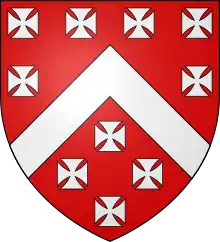Thomas de Berkeley, 1st Baron Berkeley
Thomas de Berkeley, 1st Baron Berkeley (c. 1245– 23 July 1321),[1] The Wise,[2] feudal baron of Berkeley, of Berkeley Castle in Gloucestershire, England, was a peer, soldier and diplomat.[3] His epithet, and that of each previous and subsequent head of his family, was coined by John Smyth of Nibley (d.1641), steward of the Berkeley estates, the biographer of the family and author of "Lives of the Berkeleys".

Origins
Thomas de Berkeley was born around 1245[4] at Berkeley Castle in Gloucestershire, the son of Sir Maurice de Berkeley, feudal baron of Berkeley, by his wife Isabel FitzRoy,[5] a paternal granddaughter of King John (1199-1216) through his bastard son Richard FitzRoy.
Career
He fought in the Battle of Evesham in 1265.[5] He inherited the feudal baron of Berkeley in 1281 following the death of his father and on 28 June 1283 was created 1st Baron Berkeley by writ of summons to Parliament by King Edward I (1272-1307). In June 1292 he was a commissioner to examine the claims to the crown of Scotland.[5] He was on an embassy to France in January 1296 and held the office of Vice-Constable of England in 1297.[5] He fought in the Battle of Falkirk on 22 July 1298 and was present at the Siege of Caerlaverock, Scotland, in July 1300.[5] He was on an embassy to Pope Clement V in July 1307.[5] He fought in the Battle of Bannockburn on 24 June 1314, where he was taken prisoner, and obliged to pay a large sum for his ransom.[5]
Marriage and descendants
In 1267 Thomas de Berkeley married Joan de Ferrers, a daughter of William de Ferrers, 5th Earl of Derby, by his wife Margaret de Quincy,[5] a daughter of Roger de Quincy, 2nd Earl of Winchester. By his wife he had the following children:
- Maurice de Berkeley, 2nd Baron Berkeley (April 1271 - 31 May 1326), eldest son and heir.
- Thomas Berkeley of Coston, Leicestershire, ancestor of the Berkeleys of Wymondham, Leicestershire.[6]
- John Berkeley (d. circa 1317).
- James Berkeley (d. 1327), Bishop of Exeter.
- Alice Berkeley, married Sir Ralph Stourton.
- Isabel Berkeley.
- Margaret Berkeley, married before 1321 Sir Anselm Basset of Uley.[7]
Death & succession
He died at Berkeley Castle on 23 July 1321 and was succeeded in his titles by his eldest son Maurice de Berkeley, 2nd Baron Berkeley.[5]
References
- Smyth, John (1883). The Berkeley manuscripts. The lives of the Berkeleys, lords of the honour, castle and manor of Berkeley, in the county of Gloucester, from 1066 to 1618;. Robarts - University of Toronto. Gloucester, Printed by J. Bellows.
- Cokayne
- Smyth, John (1883). The Berkeley manuscripts. The lives of the Berkeleys, lords of the honour, castle and manor of Berkeley, in the county of Gloucester, from 1066 to 1618; p. 154. Robarts - University of Toronto. Gloucester, Printed by J. Bellows.
- G. E. Cokayne; with Vicary Gibbs, H.A. Doubleday, Geoffrey H. White, Duncan Warrand and Lord Howard de Walden, editors, The Complete Peerage of England, Scotland, Ireland, Great Britain and the United Kingdom, Extant, Extinct or Dormant, new ed., 13 volumes in 14 (1910-1959; reprint in 6 volumes, Gloucester, U.K.: Alan Sutton Publishing, 2000), volume II, pages 127 & 128
- John Burke & John Bernard Burke (1844), Extinct and Dormant Baronetcies of England, Ireland and Scotland (hardback), London: John Russell Smith
- Smyth's Lives of the Berkeleys cited in Chitty, Henry; Phillipot, John (1885), The Visitation of the County of Gloucestershire taken in the year 1623, London: The Harleian Society, p. 206, retrieved 13 March 2017
| Peerage of England | ||
|---|---|---|
| Preceded by new creation |
Baron Berkeley 1295–1321 |
Succeeded by Maurice de Berkeley |